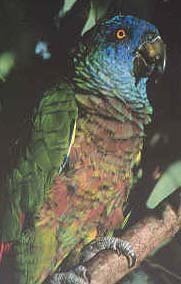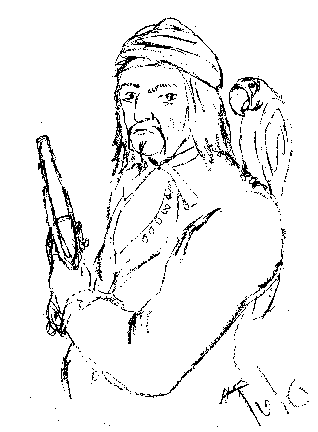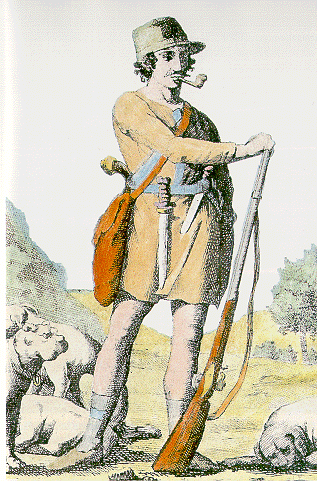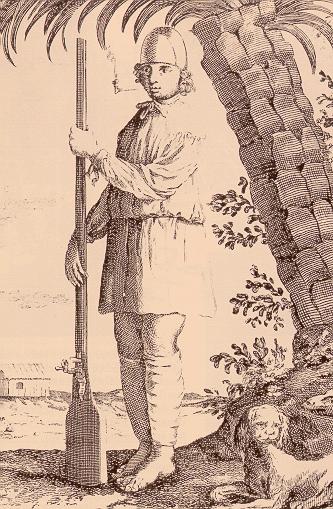
Did pirates actually keep parrots or other pets? The answer is, we don't know. There are not many first hand accounts of the animals on board ships other than the occasional comments of cats and or dogs being used to keep the vermin population down. It is safe to assume that some pirates kept pets or animals while in town and perhaps on occasion animals were taken on board ship. We know that horses and livestock were at times carried on board larger seafaring vessels when ground campaigns were to take place. We know that buccaneers got their name from roasting wild pigs.
While some sources speculate that pets such as parrots were used as emergency food rations this is unlikely, especially when it comes to a parrot. There just isn't that much there to eat. Besides, for the most part, pirates tended not to travel far and when they did roam, they stuck to known trade routes. Parrots and other exotics were also "booty".
I do not know of any historical accounts mentioning the pets of known pirates. However, there are many fictional accounts of pirates with pets and we can assume that these probably have some basis in fact. Despite the lack of known accounts, we can deduce from historical evidence that pirates probably had pets or work animals aboard ship some of the time, Why? Because for several centuries animals have been transported by ships and many ships in the Royal Navy have had cats on board. In fact a ship's cat" is quite common in many navies of the world.
Parrots
Historically, we know the following about parrots and human co-habitation. African Parrots were first brought to ancient Greece around 386 BC. In that year at the court of Artaxerxes II, the physician Ctesias gave a description of the Plum-headed Parakeet and noticed it's ability to speak. Parrots from the genus Psittacula were also well known in ancient Rome.
With the longer ocean voyages around the coast of Africa and later with the discovery of the Americas, the trade in live parrots became a regular business.
By the time of the Golden Age of Piracy, there was a well established business in exotic animals. It was not uncommon for royalty in Europe to own live animal menageries. Henry I of England established his Royal Menagerie around 1125. Philip VI of France founded the Paris Menagerie in 1333. Louis XI (1461-1483) founded the Touraine Menagerie and Louis XIV (1643-1714) the Versaille Menagerie. The actions of the Heads of Europe, were most certainly mirrored by the lesser members of the ruling class.
The more exotic the animal, the more in demand and the more valuable the animal would be. A talking bird would fetch a few doubloons in the Royal Courts of Europe, as would New World Monkeys. We also know that if something was of value, then pirates would plunder it. Some pirates were known to emulate the lifestyles of royalty so it can be assumed that this would go beyond a fine waist coat or breeches. Whatever was good enough for the royal courts was also good enough for the well-to-do Pirate. To own an exotic animal would have been a status symbol.

The parrot's social behaviour has always made it a good pet. Parrots seem to instinctively accept humans as one of their flock, which makes touching and holding the bird possible. They may learn to imitate human voices. Their ability to learn tricks and behavior which is not typical for a wild bird have made them popular with humans for century. If parrots were popular with the upper class, then pirates would want them for either status or financial gain.
Cats and dogs

Other animals such as common cats and dogs may have been living with with humans for thousands of years. The animals would have served the same practical purposes they do today. Early wood-block illustrations provide evidence that buccaneers indeed kept hunting dogs. There is also evidence that domestic animals were taken on voyages. Some scientists believe that the extinction of the Dodo Bird is directly related to the introduction of pigs, cats, and dogs to the Mauritius Island, the birds only habitat. We can assume that what was good enough for merchant ships was also good enough for a pirate ship. A good mouser on sailing ship is worth it weight in mice eaten.
Pirates were also a superstitious lot. During this time (and still today in some circles) the British merchant seaman considered the possession of black cats good luck. It was a common practice for the loved ones of a merchant marine to keep a black cat in the house while he was at sea. It was believed that so long as the cat was well fed and kept safe from harm, nothing would happen to the mariner.
Sailors also kept cats on board ships to bring them luck. Other superstitions involving sailors and cats claimed if the ship's cat approached a sailor, it meant good luck. If the cat approached halfway and turned away, bad luck would surely follow. If a cat was thrown overboard, a storm would rise and very bad luck would follow
Polydactyl cats (cats with extra toes) were always a good thing on board ships. Sailors were long-known to especially value polydactyl cats for their extraordinary climbing and hunting abilities as an aid in controlling shipboard rodents. Some sailors also considered them to be extremely good luck when at sea. Today, such cats are found throughout England and the Eastern Seaboard of the United States!.
There is no reason to doubt that an English pirate or his lover would not hold the same belief as that of other merchants of the sea.


Early Wood-Block Engravings (@ 1550) of Buccaneers with Hunting Dogs.

The only author and editor of all pages on the site. Most of what I write about is based on years of book reading on the topic. My first web page was published back in 1994.